

Evan Griffey
Photography by Carl Calvert
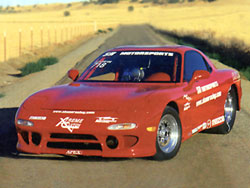 In 1998 he retired his first-gen RX-7 and constructed a back-half FD. Its mission was
R-E-S-P-E-C-T. He also hoped to take center stage and steal some of the thunder from other
Wankel pilots--a lofty goal considering his formidable competition. Ray would apply the
lessons learned on his first car (Turbo, February 1999), which ran a best of 9.26, to the
FD. The mission statement was an all-steel "Pro Street" car with full interior, full glass
with working power windows and a sunroof that works.
In 1998 he retired his first-gen RX-7 and constructed a back-half FD. Its mission was
R-E-S-P-E-C-T. He also hoped to take center stage and steal some of the thunder from other
Wankel pilots--a lofty goal considering his formidable competition. Ray would apply the
lessons learned on his first car (Turbo, February 1999), which ran a best of 9.26, to the
FD. The mission statement was an all-steel "Pro Street" car with full interior, full glass
with working power windows and a sunroof that works.
Another factor in Ray's life in the shadows was his car, a first-generation RX-7, which was out-shined by Abel's full-race R-100 and Adam's more-modern current-generation RX-7. Furthermore, since Ray ran methanol he was put in a different class than Adam who ran in the core class of import drag racing, the bustlingly-popular Quick Class. Considering the aforementioned factors, it is easy to see why Ray has felt like the Rodney Dangerfield of the import drag racing scene for the past few years.
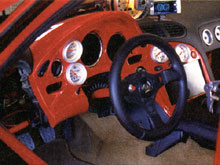 SR Motorsports PowerStation
SR Motorsports PowerStation
The Mazda, destined for the Outlaw class of import drag racing, attains its near-warp
quickness from a Cosmo 13B rotary built by Ray's company, SR Motorsports. The turbo-ported
powerplant is pressurized by a KKK turbo that was built to his own secret specs. The turbo,
positioned by a custom SR Motorsports exhaust manifold, blows through a liquid-to-air
Spearco intercooler and is regulated to 20 psi by an Apex Racing wastegate and Apex Super
AVC Type-R electronic boost controller. Boost relief between shifts is provided by a
twin-chamber Apex blow-off valve. The key to generating big-league Wankel power and
making it live is tuning. Tuning is a balancing act between air, fuel and spark. The
trick is finding and maintaining a ratio that produces prodigious power without inducing
meltdown. Since Ray is running stock apex seals and these are known to react poorly to
detonation tuning was all the more critical.
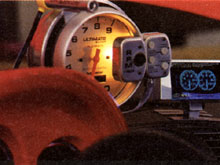 Like Ray's first RX-7, the FD burns methanol. Ray prefers everything from the smell of
methanol to its burning characteristics. Since it has a high octane value and burns cool,
more boost and more timing can be run in the engine. Ray admits he is currently not taking
full advantage of these characteristics which means there is still potential in the motor.
A Weldon 170-gpm pump feeds eight 850cc injectors via -8 fuel lines while pressure at the
custom fuel rail is controlled by an SX regulator. The spark side is handled by an
Electromotive TEC-II, Moroso Blue Max wires and NGK race plugs.
Like Ray's first RX-7, the FD burns methanol. Ray prefers everything from the smell of
methanol to its burning characteristics. Since it has a high octane value and burns cool,
more boost and more timing can be run in the engine. Ray admits he is currently not taking
full advantage of these characteristics which means there is still potential in the motor.
A Weldon 170-gpm pump feeds eight 850cc injectors via -8 fuel lines while pressure at the
custom fuel rail is controlled by an SX regulator. The spark side is handled by an
Electromotive TEC-II, Moroso Blue Max wires and NGK race plugs.
Tuning The Combination
The 13B is controlled by an Electromotive TEC-II engine management system. Ray gives the
unit high marks, "The TEC-II gives us precise control of all engine-related variables. It
allows us to datalog an entire quarter-mile run in real time. This helps to quickly
identify problems and tune them out. Other systems we have used didn't allow us to datalog
so it was difficult to, 'A' know if tuning was needed and, 'B' know where (in the rpm band)
tuning was needed." The TEC-II uses a crank-fire set-up to orchestrate ignition and fueling
events. The engine management computer is programable via laptop computer and uses proven
thermodynamic algorithims in place of multiple fuel and ignition maps which allows the user
to easily set baseline programs and advance to the fine-tuning stage. The versatile TEC-II
can be programmed to tune for turbo-and/or nitrous-enhanced engines and can utilize either
mass air or speed density metering controls. Electromotive is constantly evolving its
software and developed new programs for Hondas in 1999. For 2000 Electromotive has big
plans. At the SEMA Show in November 1999, the company plans to unleash new software that
is Windows(TM) 95 compatible and features many new programming possibilities. One of the
more interesting aspects of the program is the tutorial feature where the user inputs such
parameters as injector size, fuel pressure, engine size, boost among others and the
programs detects any conflicts or possible shortcomings. Electromotive reports this
function was designed because all too often complaints about poor tuning are caused by
overwhelmed fuel systems not the TEC-II. Now users will have the information to lay a good
performance foundation before the first key stroke.
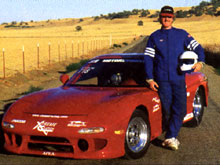 Ray is a big supporter of the TEC-II and his impressive power production testifies to
the effectiveness of the components. The 13B generated an impressive 561 horsepower at
Superior Dynojet of Fairfield, California.
Ray is a big supporter of the TEC-II and his impressive power production testifies to
the effectiveness of the components. The 13B generated an impressive 561 horsepower at
Superior Dynojet of Fairfield, California.
Not Playing The Numbers Game
With the widespread availability of chassis dynos it is easy to get caught up in a numbers
game. Tickling the keys one last time to extract the extra couple of horses can offer
declining dividends with the downside being grenaded rotor housings. Hardcore racers like
Ray know that power means nothing unless it's harnessed by the chassis and suspension and
put to the ground. The only number that counts is the one flashed on the scoreboard at the
end of the strip.
Up front, the Mazda retains its factory suspension configuration. A pair of Apex N1 adjustable shocks and Apex springs work with Weld Racing Aluma-Star wheels and skinny tires to guide the RX-7 down the strip. The rear is a different story with the suspension being incorporated into the chassis. A four-link set-up featuring Competition Engineering shocks locates a Strange Ford 9-inch rearend that sports a 5.30 gear ratio. The Ford 9-inch spins Strange 35-spline axles that drive 31x13 Hoosier slicks mounted on 15x12 Aluma-Stars. The chassis, which includes a 14-point roll cage, was constructed by SR Motorsports and is fully NHRA approved.
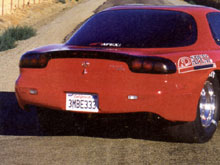 A Jerico four-speed transmission transfers the power from a special billet flywheel to
the ground. The gearbox is actuated by a six-puck Advanced Clutch Technology Extreme(TM)
clutch and durable Long shifter. Race-proven Wilwood binders are on call at the corners to
slow the Mazda down after it screams through the traps.
A Jerico four-speed transmission transfers the power from a special billet flywheel to
the ground. The gearbox is actuated by a six-puck Advanced Clutch Technology Extreme(TM)
clutch and durable Long shifter. Race-proven Wilwood binders are on call at the corners to
slow the Mazda down after it screams through the traps.
To compete with high-profile racers you have to run the number and look good doing it. To this end, Ray has made the right moves. The FD sports an Apex front bumper and side skirts to give it a more muscular silhouette. The body tuning pieces were installed, and the Mazda was prepped and painted '99 Corvette Red by Mike's Auto Body of Concord, California. Also part of the visual equation is the interior. The cabin features a red-trimmed dash that houses gauges from Auto Meter and Apex and secure RCI racing buckets. In the interior portion of our tech sheet under "Sound System" Ray jotted down "Three-inch straight-through exhaust, no stereo needed."
The car hit the strip, blasting a 9.60 at 136 during its initial shakedown time trials at Palmdale prior to the first 1999 Battle. From there, Ray has worked diligently to evolve the Mazda's performance tuning the suspension to get the most out of the thrust at hand. He credits tuning and, most importantly, the Apex electronics for his success. Prior to the AVC Type-R boost controller, Ray used no controller at all, only wastegate spring pressure regulated boost. As a result, the engine generated less boost at launch and in lower gears. With the AVC Type-R Ray was able to tailor the boost curve to the launching habits of the car. His efforts paid off when the red rocket became the first Outlaw-class car in the eights, scorching an 8.98 at 148 mph. "I really wanted to get in the eights all turbo but I'm tired of taking baby steps. I'm going to add some nitrous and get leaping." He hopes to hop into the 8.40s then attack the sevens. This plan is still under consideration. He is also weighing the possibilities of going to a bigger turbo. He reports the current turbo is out of compressor. He has turned up the boost yet seen no improvements in e.t.s. He also has a 20B three-rotor warming up in the silo. The engine is ready to run and Ray expects to see 900 horsepower. No matter what avenue he takes, we expect to see e.t.s drop.
Needless to say, Ray and his RX-7 have emerged from the shadows and the duo should be a force in the up-and-coming Outlaw class. We think he has earned his stripes and done it the right way--a quarter mile at a time.

[Mail me] [To Lightning home] [To my home page] [Copyright Notice]